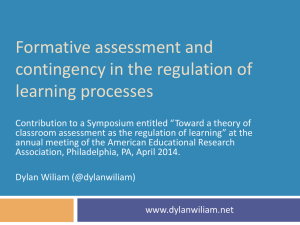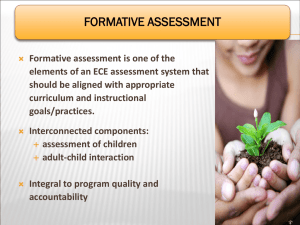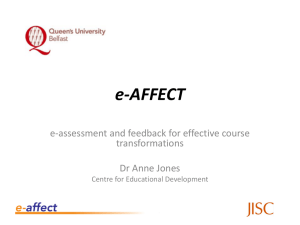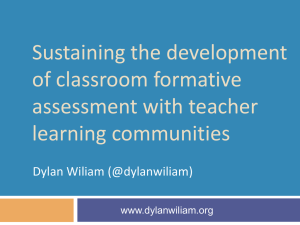Formative Assessment - Granite State College
advertisement
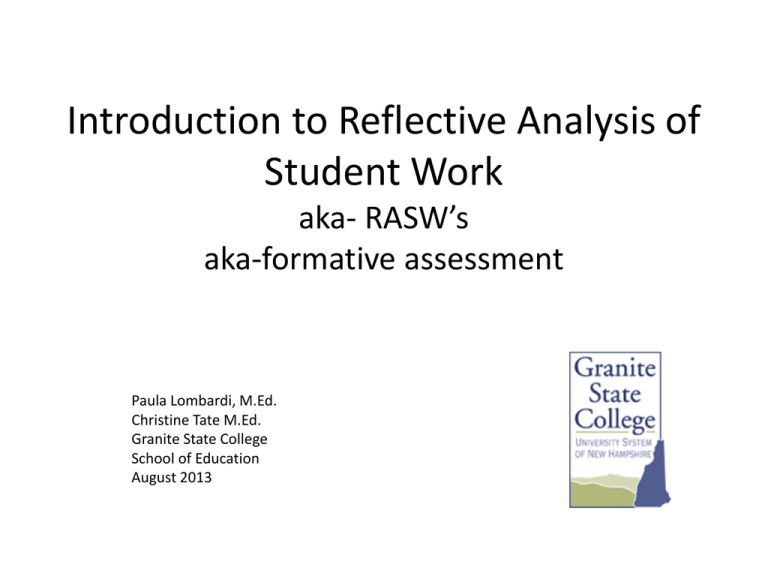
Introduction to Reflective Analysis of Student Work aka- RASW’s aka-formative assessment Paula Lombardi, M.Ed. Christine Tate M.Ed. Granite State College School of Education August 2013 Dylan Wiliam, Learning forum L7 at the North of England Education Conference, January 2010: York, UK www.dylanwiliam.net REFLECTIVE ANALYSIS “Sivasailam Thiagarjan (Thiagi),…stated that [people] only learn when they reflect on experience. …reflective learning is the most powerful learning system, because it takes into consideration emotions, interactions, thoughts, and behaviors generated by the other learning systems. Reflective learning involves: Mentally recreating… Analyzing choices… Intellectually experimenting with strategies… Meta-cognitively monitoring and cultivating one’s own thinking… …constructing knowledge…” Millen, E.M., Greenleaf, R.K., Wells-Papanek, D., Orvis, S. L. (2007). Engaging today’s students, grades 5-12 edition. Newfield, ME: Greenleaf & Papanek Publications. (pg. 61) You will be required to practice formative assessment throughout your program of study at Granite State College in the following settings: 1:1, small group, and whole class Depending on your level of knowledge, you should refer to the Chapter “Assessing Students for Instruction” in Mercer and Mercer, Teaching Students with Learning Difficulties. Read or if you have already done so, review the section/ “Individualized programming - A continuous Process of Assessment and Teaching” to prepare for you formative assessment requirement. The formative assessment process is recommended for special education (clinical teaching) teachers as well as for classroom teachers addressing standard based outcomes. GSC LESSON PLAN FORMAT For each lesson plan you will be required discuss and determine how you will evaluate the lesson objectives and student outcomes. It is expected that you will include formative assessment in your lesson plans. This is a segment from the GSC lesson Plan Form. Note that the formative assessment process in the individual student (RASWs) and the whole class lesson plan, follow the same basic principles. Similar to other teacher planning tasks, RASW is an ongoing and cyclical process, planning before, during and after instruction. Reflective Analysis Of Student Work (RASW) • The purpose of the RASW is to help you form a “habit of mind” where you are reflecting upon WHY a student is struggling with a task. You are trying to determine what is making the task difficult for the student. You then try to address the issues in order to help the student to make progress. You are reflecting on your impact on the student- are they learning? And if not, why? Steps to RASW 1. Focused learning target and formative evidence/ data 2. Reflective Analysis 3. Professional Learning Networks 4. Strategy/ next step • In your School of Education methods courses you will record your reflective analysis of student work on specific worksheet and/or eform. ”RASWs” • The next slides address the information that you will collect on these forms Step 1. Focused Learning Target and Formative Assessment Evidence/Data This step is broken into 3 sub steps. If you begin to get confused, remember, all you are really doing is choosing a skill to work on, breaking it into its subs kills, and providing data/evidence for the level the student is at or where the process is breaking down for the student. 1a. Identify a measureable goal. This could be a goal from a student’s IEP, a Common Core Standard, or from the Early Childhood Learning Guidelines. Example: Geraldine will read 110 WCPM with 90% accuracy when reading a 3rd grade passage by June 2014, as measured by the special educator, using running records. 1b. Identify a measurable learning target by breaking the goal into its subs kills. For example, in order to read fluently, Geraldine needs to be able to decode words, recognize sight words, have vocabulary skills, etc. Once you have broken the larger goals into subs kills it will be easier for you to determine where the process is breaking down for the student when you give them an assessment. Example: By the end of three weeks, Geraldine will read words containing the digraphs sh, th, and ch in connected texts with 90% accuracy. ( I bet you’re wondering HOW I came to this learning target. I discovered that digraphs were her weakness when I gave her a fluency assessment) Step 1. Focused Learning Target and Formative Assessment Evidence/Data cont… 1c. Articulate the results of the evidence gathered. This is where you cite the information from the assessment that was given to the student. Example: Geraldine was administered an informal reading inventory. She had difficulty reading ch, th, and sh. Her accuracy for those digraphs was 40% and she demonstrated poor phrasing. Student work example: In writing a paragraph, Geraldine misspelled 3 our of 3 words containing digraphs. Reflective Analysis 2. • • • • • Based on the data, what questions arose about the student’s learning needs. These MUST be in question format. Example: Does Geraldine hear the sounds correctly? Is articulation an issue? Can she say them correctly in conversation? Could she read the digraphs correctly? Does she misread the digraphs in all positions of words? Has this child received interventions in the past? Reflective Collaboration 3. Who did you engage and what purposeful feedback was provided to guide your next step? Who are your “go to people”? A website? A colleague? Specialists in your school? Did you review the student’s special education file? Previous testing? Cumulative file? • Example: Nurse • Speech Therapist • Reading Specialist/Classroom teacher • Special Education file and cumulative file • More importantly here… what did they say/suggest might be the learning issue and ways to consider addressing it? What is your strategy/next step? 4a Next Step? [Consider duration, frequency, intensity, before change.] What behavioral strategy that is DIRECTLY LINKED to the formative data/student performance will you use? Example: Teach target digraphs in isolation with picture clues for one week, (five one on one sessions for 15 minutes each) 4b. Assessment: How will you assess the skill? Example: Give the student 10 sentences to read with 20 opportunities to read target digraphs in words in the beginning, medial, and final positions in words. Then, check to see if the student responds more or less successfully to the position of the digraph in words. Also, not whether the rate of success is different with any given digraph over others. And the cycle begins all over again from the beginning. Can you increase the learning target? Do you need to change it? RASW Criteria: © 2013 Cycle of Reflective Analysis of Student Work Baseline Evidence Analysis of student work PLC Criteria 1: Criteria 2: Criteria 3: Focused Learning Target & Formative Evidence / Data Reflective Analysis PLN: Professional Learning Networks Engaged A. Overarching CCSS, NH standard, NAEYC, IEP goal or other overarching goal. B. Learning Target: C. Evidence gathered / new data (formative based); student work! The data prompted what questions about the student’s learning needs? What sources did you engage and what feedback was provided? Formative assessment Evidence Criteria 4: Strategy: Next Step? A. What strategy will you use, that is DIRECTLY LINKED to the formative data collected? B. What evidence will you collect to inform how the student responded to your selected approach? Iterative Template: © 2013 Cycle of Reflective Analysis of Student Work START Iterative RASW formative cycle represents a “habit of mind” important for educators today Interval #1 a & b Articulated goal; Identify learning need Interval #1c. RASW #4a&b BASELINE data/evidence Strategy applied + Through Reflective Analysis(#2) & PLN (#3) Formative Feedback set up Interval #2 1c. Newly Obtained Formative Feedback Through Reflective Analysis (#2) & PLN (#3) RASW #4a&b Strategy applied + Formative Feedback set up Interval #3 1c. Newly Obtained Formative Feedback Through Reflective Analysis (#2) & PLN (#3) RASW #4a&b Strategy applied + Formative Feedback set up Guiding QUESTIONS 8.14.13 Regarding the GSC Reflective Analysis of Student Work Rubric Criteria 1. Identifying a specific learning target 2. Reflective Analysis 3. Engage a PLN, Mentor, Expert 4. Link Strategy to learning need Criteria #1: Criteria #2: Criteria #3: Criteria #4: The TC must select a measureable goal, The TC must analyze the data from Once the TC has completed their This completes the cycle by linking then select a sub-component of that criteria #1 and develop QUESTIONS reflective analysis, they confer with the evidence available, the analysis overarching goal. In order to obtain points regarding the student's learning others about their evidence, prospective of learning needs and the advice/input for this criteria, the TC must list data that needs, based on the evidence put learning needs and possible best of colleagues, experts and mentors -addresses this area, provide info that forth. Questions must be about practices to consider on behalf of their to determine an approach/ clearly outlines a learning need and potential requisites for learning, student. activity/strategy to use with the develop a specific learning target, that is not about teaching strategies. student. How the IMPACT (measurable measurable, to proceed with. Then, student learning) of this choice will be address current evidence referencing assessed must also be addressed. actual STUDENT WORK. A. Have you asked questions A. Have you presented the evidence to a A. Have you listed a Measurable goal or it's about the student and his/her mentor, colleague or other professional equivalent? learning that stem from the evidence for their input? What did they say? provided in the criteria #1 column? B. Have you noted available evidence/ data that provides sufficient input for identifying a measurable learning target, that aligns with the student's overall learning goal? C. Have you included recent, current (some from the last week or two) available evidence/data that can be used to support analysis, inquiry, and the development of an academic or behavioral learning target specific enough to lead to a prospective strategy to address the coming week's instructional focus? Cite actual student work/performance over the past week. B. Do your questions speak to learning issues clearly related to the identified learning target in column 1, row B to the left? (Do not articulate instructional strategies or overall student learning styles here) A. Is a direct result of the latest evidence (column 1) linked to a selection of instructional activities for the student? B. Have the tasks indicated for the B. Have you sought out any research or student to undertake clearly linked to on-line resources for input? What did the goals, learning target, evidence you learn? gathered and input generated through reflective analysis (columns 2 & 3)? C. Is any progress / impact on intended outcomes measureable? C. Do your questions clearly speak How will you know whether the to learning issues related to the C. Have you articulated key components approach you have selected has current evidence collected in of the discussion(s) held or information impact? column 1, row C to the left? gathered and summarized any D. Will gathering evidence from this (Do not articulate instructional conclusions drawn? instructional approach provide strategies or overall student learning adequate evidence for you to restyles here) engage this cycle back in column 1, . Vertical Template:© 2013 Cycle of Reflective Analysis of Student Work Criteria 1: Focused Learning Target & Formative Evidence / Data A. Write the overarching goal you are addressing. B. Identify a measurable learning target within the scope of the goal C. Articulate the: evidence gathered; any issues, patterns, concerns, the data suggests; any other items of note. A. Overarching goal B. Learning Target: C. Evidence gathered / new data (formative feedback gathered most recently): Criteria 2: Criteria 3: Reflective Analysis The data prompted what questions about the student’s learning needs? Professional Learning Networks Engaged What sources did you engage and what feedback was provided? Criteria 4: Strategy:Next Step? a. What academic/ behavioral strategy will you use, that is DIRECTLY LINKED to the formative data/evidence collected, that is intended to impact learning outcomes? b. What evidence will you collect to inform how the student responded to your selected approach? . Horizontal Template:© 2013 Cycle of Reflective Analysis of Student Work Criteria 1: Focused Learning Target & Formative Evidence / Data A. Write the overarching goal you are addressing. B. Identify a measurable learning target within the scope of the goal C. Articulate the: •evidence gathered •any issues, patterns, concerns, the data suggests •any other items of note. Criteria 2: Reflective Analysis The data prompted what questions about the student’s learning needs? Criteria 4: Strategy: Next Step? Criteria 3: Professional Learning Networks Engaged What sources did you engage and what feedback was provided? A. Overarching goal What strategy will you use, that is DIRECTLY LINKED to the formative data collected? A. B. Learning Target: C. Evidence gathered / new data (formative based): Learning Target Focused, with Appropriate Data: RATING: B. Rating: Cycle leads to… Rating: Rating: Rating: Strategy Directly & Clearly Linked WHOLE CLASS/SMALL GROUP RASW PROCEDURE POINTS OF INTEREST (8.14.2013) 1b. Measureable Learning Target—subset of the overarching area that is the focal point for the upcoming interval: Write the specific learning target for the upcoming lesson(s) that is related to your area of focus for this week’s lessons. Typically this specific learning target is pivotal for understanding and moving forward. How was this target determined? (not via IEP) What makes this learning target important to ALL students overall understanding and success? 1c. Evidence gathered that led to the selection of the learning target: * Class or small group’s learning evidence that supports the specific direction that instruction needs to address • Actual student work on items, prompts, worksheets, etc. is very useful here • Look for patterns across student work for common errors or misunderstandings or pivotal components to generate progress. Citing actual student work is a vital part of this evidence. 4. What tasks and/or approach will you use in upcoming lessons to impact the identified learning target—based on #1c ,#2, and #3? Articulate: * The primary learning need to be targeted •The strategy you will use to address the specific learning target •Why this is a good choice. 4b. Articulate what new evidence will be generated as feedback regarding the impact of the instructional choice on the class/group learning and capacity to move forward (or not) with their essential understanding or skills. To learn more about formative assessment check out these resources Online articles/blogs: • The Best Value in Formative Assessment- Stephen Chappuis and Jan Chappuis • Seven Keys to Effective Feedback- Grant Wiggins • Research Says / Good Feedback Is Targeted, Specific, Timely, Bryan Goodwin and Kirsten Miller • How Do We Train Teachers in Formative Assessment? By Stephen Sawchuk • Formative Assessment and Next-Generation Assessment Systems: • Are We Losing an Opportunity? Paper prepared for the Council of Chief State School Officers , September 2010 Books/papers: • Embedded Formative Assessment, Wiliam, Dylan • Formative Assessment Micro-Feedback Loops Using the Student-Centered Accountability for Learning Process, Dr. Robert K. Greenleaf • On Common Ground, The Power of Professional Learning Communities, DuFour, DuFour, & Eaker (Eds.) • Inside the Black Box: Raising Standards Through Classroom Assessment By Paul Black and Dylan Wiliam This webcast is a comprehensive presentation on the big picture and details of Formative Assessment. It is 92 minutes, so find yourself a quiet place and watch, listen, and take notes. Sara Bryant, Professional Development Specialist from Measured Progress, presents a webcast on: Engaging Teachers in Formative Assessment to Improve Learning. Click on hyperlink to view video http://www.mistreamnet.com/vidflv.php?who=mac042711 Rick Wormeli: Formative and Summative Assessment Rick Wormeli, author of Fair Isn't Always Equal and Differentiation, explains the difference between the two and how formative assessment helps you offer better feedback to your students. Click on hyperlink to view Rick’s video (4.48 minutes) https://www.youtube.com/watch?v=rJxFXjfB_B4 • Contact your Course Instructor or • Contact your Field Placement Faculty
